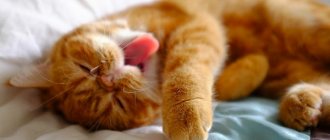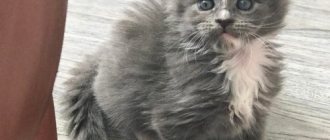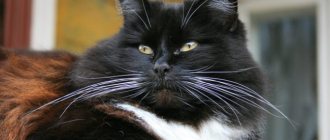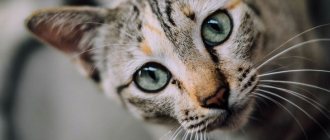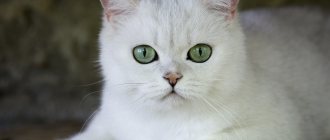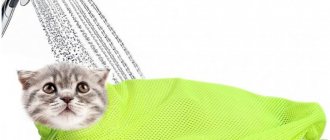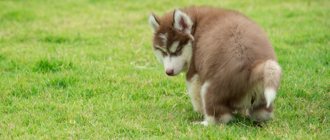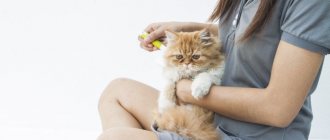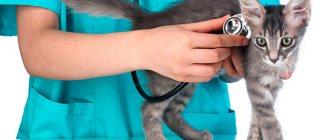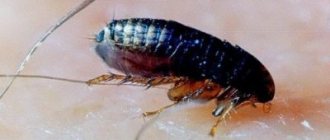Constipation in cats is one of the problems faced by owners who switch their pets to a biologically appropriate diet. But as practice shows, cats do not suffer from constipation on a healthy diet. On the contrary, natural food has a positive effect on cats’ digestion. Because of these changes, the stool changes: the amount noticeably decreases, the stool becomes less odorous. Such changes make owners anxious, but in reality there is nothing wrong with your pet, and here's why.
Why do cats eat fur and what can replace it with?
In nature, cats eat their prey whole: meat, bones, fur and feathers. There are no nutrients in wool. It has purely mechanical functions: it helps remove plaque from teeth and increases the volume of feces. Wool is not digested in the stomach. But it takes up space in the gastrointestinal tract. Thus, wool irritates the walls of the gastrointestinal tract and stimulates peristalsis. The food mass passes through the gastrointestinal tract faster and is eliminated from the body.
The natural diet for domestic cats is very similar in composition to the natural prey of wild relatives. The difference is that no wool is added to natural food. It is replaced with vegetables. Vegetables are a source of insoluble fiber. The body does not absorb it, but it absorbs water, increasing the volume of food mass. In theory, fiber should do the same thing that wool does. But wool is a protein, and plant fiber is based on cellulose and starch.
Diagnostic features
To find out why a cat has blood in its stool, a veterinarian performs a diagnosis. The procedure involves the use of different techniques, but first of all, blood is taken for a detailed analysis. It is also necessary to submit your pet’s stool to be examined for protozoan microorganisms and helminths, as well as to detect internal bleeding.
A laboratory method called coprogram is highly informative at the stage of diagnosing diseases in cats. With its help, you can find out what microscopic composition the blood in cat feces has, as well as identify hidden bleeding. Additional tests performed when blood is detected in a cat's stool:
- Analysis of urine;
- Ultrasound of the abdominal organs;
- X-ray of the abdominal organs;
- colonoscopy examination.
A set of diagnostic procedures allows the veterinarian to make the correct diagnosis and create an effective treatment regimen.
What should the stool look like?
Cats evolved in the steppe, arid climates of Africa and the Middle East. There's little water there. The cat's body has adapted to save water: cats can limit themselves only to the liquid that they receive from their prey. Therefore, they do not sweat and do not suffer from rapid breathing in the heat, like dogs. And that's why their urine is very dense. The cat's body tries to waste as little fluid as possible. Because of this, cat feces are very hard in their natural environment. It looks more like pellets: whitish or with a yellow tint, crumbly, with an admixture of cat hairs or prey hairs.
This is what normal cat poop looks like
The fewer ingredients a cat digests, the more often it goes to the litter box. Industrial feed contains many ingredients with low nutritional value. Most of the ingredients are poorly absorbed by cats. Therefore, cats that eat dry food go to the litter box more often. Their stool is bulky, loose, and has a pungent odor.
Diagnosis of the condition
A pet with a characteristic symptom should be shown to a veterinarian who, after a clinical examination, will prescribe certain diagnostic methods. First of all, the doctor will conduct a detailed blood test, stool examination for helminths, protozoa, and occult blood.
An informative research method is the coprogram. Using this laboratory method, you can find out not only the microscopic composition, but also detect hidden blood in the feces of an animal. If necessary, a urine test will be performed. An ultrasound or X-ray examination of the abdominal organs, as well as a colonoscopy, can be used to find out why a cat poops blood.
We suggest you read: Elephant in the zoo what elephants eat in captivity
Constipation in cats: signs
Cats fed SUPERPET usually have dry, hard stool. These cats may only defecate a couple of times a week. If there are no other warning signs, your pet is fine.
You should worry if
- the cat often goes to the litter box, but to no avail;
- the cat defecates less than 1-2 times a week;
- the cat has difficulty defecating;
- The cat has lost her appetite and is vomiting;
- the cat has become restless or has decreased activity sharply.
If these symptoms appear, you should immediately contact your veterinarian. Constipation in cats is not always caused by diet. The veterinarian will determine the cause and help eliminate it. In acute cases, the doctor may prescribe an enema and prescribe a laxative.
Diagnostics and pre-medical preparation
Before contacting a veterinary clinic, the owner should carefully observe his pet so that the results of these observations will help the doctor make the correct diagnosis.
It is important to pay attention to the following points:
- how often does the cat bleed: once or after each visit to the toilet;
- how much blood the feces contain: a drop, a few drops, a clot or a large amount;
- are there any impurities in the stool: mucus, clots, hairballs, undigested food;
- how the cat behaves during defecation: screams, tense, worried or relaxed and calm;
- what happens to the pet’s appetite: the cat refuses to eat, the appetite is decreased or increased;
- how often does he drink water: is the animal thirsty;
- whether he has any accompanying symptoms: fever, vomiting, bloody diarrhea or constipation.
All changes in the pet’s condition and behavior must be described in detail to the veterinarian during the medical appointment.
How to prevent constipation
There are many different ways to prevent constipation in cats. Some methods work better, some worse. It all depends on your cat.
Some remedies that may help
Vegetables
Vegetables can help relieve constipation in cats: boiled pumpkin, carrots or green beans. Vegetables in a cat's diet have two positive effects:
- the moisture content of food increases, making it easier for food to move through the intestines;
- the proportion of fiber increases, which improves intestinal motility.
Vegetables should be introduced into your pet’s diet carefully and little by little so as not to cause gas.
More food
The more often cats eat, the more often they defecate. With frequent emptying of the stomach, the stool does not have time to become too dry. Sedentary cats who eat little are more likely to be constipated than active cats with a good appetite.
cat hair
Cat hair and prey hair increase the volume of feces. Cats eat their fur when they groom themselves. Do not get carried away with combing and washing your pet: this way you deprive him of a natural laxative. Cats that eat natural food practically do not regurgitate hairballs. If your cat spits up hair frequently, eats a lot of grass, and is vomiting, something is wrong. In this case, you need to contact a veterinarian.
Magnesium
Magnesium is responsible for muscle function. It relaxes muscles and promotes normal functioning of the gastrointestinal tract. Thanks to magnesium, the amount of fluid in the large intestine of cats increases: the stool becomes softer. But magnesium is associated with the formation of struvite crystals in urine. Excess crystals cause urolithiasis. Therefore, in many feeds the proportion of magnesium is reduced. Lack of this element leads to constipation. It is important that cats consume enough magnesium.
Raw liver and fats
Raw liver is a mild natural laxative. Fats help speed up digestion and make trips to the litter box more frequent. Instead of fattier types of meat, you can add rapeseed or sunflower oil to your food. Some cats love olive oil. Cats do not digest vegetable fats well; the oil can help with constipation as a lubricant.
Ground sunflower seeds
Sunflower seeds can be ground in a coffee grinder and added to food. The seeds are practically not digested, so the stool becomes bulkier. By adding crushed seeds to food, you imitate the stomach contents of mice.
Ground flaxseeds
Raw flaxseeds can be dangerous for cats. They contain substances that, when water is added, turn into hydrocyanic acid. This is a very dangerous toxin. Therefore, before giving flaxseeds to cats, they need to be boiled. Boiled crushed flaxseeds make stool softer.
Psyllium seed husk
This remedy is also known as psyllium. People often use psyllium as a remedy to prevent constipation. Some veterinarians recommend it for cats that suffer from constipation. However, if you give cats psyllium for a long time, their body gets used to it and it stops helping. Therefore, psyllium can be used as a short-term therapeutic agent.
Water
Water will not help relieve constipation. The amount of urine will increase, but the stool will not become softer. As your cat starts drinking more, she will eat less. This is because the same amount of food will contain more liquid. Due to the fact that the cat will eat less, less food will pass through the gastrointestinal tract. The cat's condition will worsen.
Treatment tactics depending on the cause of the symptom
Some causes of blood in a cat's stool require medical intervention. For example, if an animal has swallowed a foreign object, it needs to undergo urgent surgery (otherwise the cat will die). If the owner notices bloody feces in a cat, he and his pet should immediately visit a veterinarian. Fulfilling this requirement is especially important if the animal develops the following alarming symptoms:
- painful sensations during bowel movements;
- stomach ache;
- vomit;
- decreased appetite;
- weakness;
- blood and mucus in the cat’s stool;
- heat;
- the presence of blood or blood clots around the cat's anus.
The cat's body is exposed to great stress when bleeding and damage occurs in the intestines. To prevent the animal from experiencing unbearable pain, the owner must promptly pay attention to the pet’s health problems, provide first aid and conduct a thorough diagnosis in a veterinary clinic.
The behavior and well-being of a pet is an indicator of its health. If, during occasional blackening of the feces, the animal is in an active and cheerful state, there is no reason to contact a veterinarian. Immediate delivery to a veterinary clinic requires the appearance of the following symptoms:
- Bloody clots in the stool, which are a sign of internal bleeding in one of the organs of the digestive system. This phenomenon is very dangerous. The slightest delay in this situation can result in the death of your pet.
- Changing the cat's behavior. A pitiful meow that intensifies when you try to touch his stomach, and slight trembling are sure signs of problems in the gastrointestinal system.
- Hyperthermic syndrome.
- Melena (black, semi-liquid stool with a foul odor).
- Vomiting or false retching.
- Lethargy. A very dangerous sign is the state of a pet when it lies indifferently, pressing its muzzle to the floor, and does not react to external stimuli.
- Decreased appetite or complete refusal to eat.
- Absence or, on the contrary, excessive thirst.
- Increased frequency of the urge to empty the bladder.
- Pallor of gingival tissues.
- Wounds or hematomas on the body.
When diagnosing stones or neoplasms in a cat, or detecting a foreign object, there is only one way out - surgical intervention. In other cases, the treatment plan is developed individually for each four-legged patient.
| Main disease | Group of drugs | Names of drugs |
| Worm infestation | Antiparasitic | Milbemax, Stronghold, Prasitel, Drontal, Dirofen |
| Sand in the gallbladder | Choleretic | Cholenzyme, Allochol, dehydrocholic acid |
| Inflammation | Antibiotics | Streptomycin, Erythromycin |
| Antiviral | Fosprenil, Anandin, Gamapren, Gamavit, Cycloferon | |
| Stomach lesions | Gastroprotectors | De-Nol, Maalox, Almagel, Ranitidine |
Do cats need plant fiber?
Plant fiber is needed by herbivores and omnivores. Since cats are obligate carnivores, their stomachs are not designed to digest large amounts of plant fiber. With plant fiber, bacteria enter the cat's body and disrupt the microflora of the gastrointestinal tract. When defrosting, bacteria release gases. Not only are gases uncomfortable for cats, but they can also be toxic and lead to inflammation. Inflammation causes diarrhea.
If you decide to include plant fiber in your cat's diet, this must be done very carefully. Keep track of how often your pet burps and whether it suffers from gas or diarrhea. Due to the high fiber content, cats' bodies may be less able to absorb nutrients.
If you have constipation, you should not give fiber to cats that regurgitate frequently. Fiber makes regurgitation worse. Cats that spit up need to be fed small, frequent meals. Food should be easily digestible and have high nutritional value. Such cats may suffer from constipation because not enough food passes through the gastrointestinal tract. Frequent feeding should help relieve constipation.

